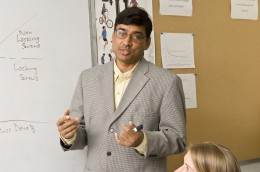
Associate professor Tarun Goswami and his team are investigating how much force is required to produce a concussion and brain injury like those suffered in combat, jet flight and even sports.
Wright State researchers are putting their brains to work on the problem of brain injuries.
Led by Tarun Goswami, joint associate professor of biomedical engineering and orthopaedic surgery, a team of engineering researchers is investigating how much force is required to produce a concussion and brain injury.
The researchers are working to quantify acceleration and impact forces in hopes it will lead to the development of revolutionary protective gear.
“We look at the forces that are applied to the brain, how they rotate the brain,” Goswami said. “The skull may be stationary, but the brain tries to move. Wherever it goes impacts the internal walls of the skull. It may cause bleeding in some cases.”
The Centers for Disease Control say an estimated 1.7 million Americans suffer a traumatic brain injury annually. That comes at a cost of $25 billion or more.
“It’s widespread. The numbers are really, really staggering,” Goswami said.
Goswami’s team is conducting research looking into brain and spinal injuries similar to that suffered by those in war zones and other demanding environments such as jet flights that subject the brain to high G forces.
While the research is more biomechanical based, in that forces, motion, displacement and strains are evaluated, the research is also aimed at producing a more protective helmet, perhaps consisting of stronger, lighter materials or even featuring sensors that measure the severity of blows.
But Goswami said about half of brain injuries are sports related and that more than 7 million American children are involved in sports.
The number of children going to the emergency room for concussions they suffered while playing competitive sports has more than doubled in recent years, which some say may be due in part to a growing awareness of the brain injury.
A study published in the journal Pediatrics in August 2010 found that, although most of the increase in hospital visits came from high school athletes, 40 percent of sports-related pediatric concussion patients seen in the ERs were between the ages of 8 and 13. The study was conducted by four physicians affiliated with the Brown University Medical School.
Concussions and brain injuries can immediately reveal themselves in functional behavior, creating cognitive disabilities.
“You tend to see that you are losing some memory. Then you probably have headaches, repeated headaches, even migraines,” Goswami said. “In cases of severe injury, there will be blackouts, losing consciousness.”
Goswami said there is a need to spread the word among students and teachers in middle and high schools to be vigilant and take seriously any impact to the head.
Some schools have begun using a computer software program that screens athletes for concussions. Before the season, the athletes take a series of tests that measure such things as their attention span, working memory, problem-solving skills and reaction time. If, during the season, the players are suspected to have suffered a concussion, they retake the test and the results compared to those of the previous test.

 Museum-quality replica of historic Hawthorn Hill donated to Wright State
Museum-quality replica of historic Hawthorn Hill donated to Wright State  Wright State celebrates more than 1,000 graduates at fall 2025 commencement
Wright State celebrates more than 1,000 graduates at fall 2025 commencement  2026 Alumni Achievement Awards celebrate distinguished Wright State community members
2026 Alumni Achievement Awards celebrate distinguished Wright State community members  Bags, boards and bonding
Bags, boards and bonding  More than 1,000 students to graduate at Wright State’s fall commencement ceremonies
More than 1,000 students to graduate at Wright State’s fall commencement ceremonies 